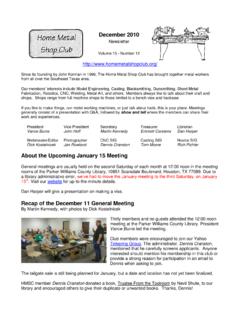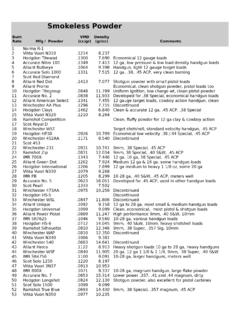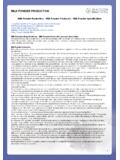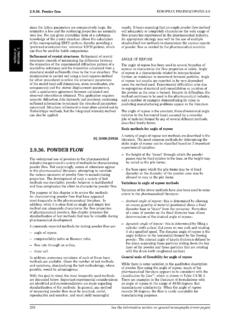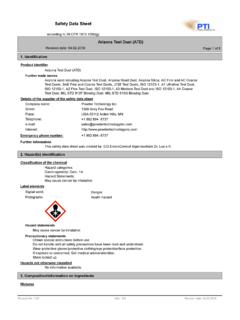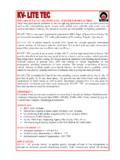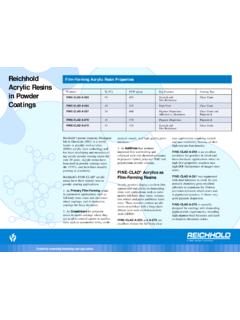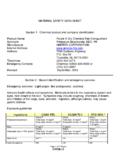Transcription of Powder Coating in the Home Shop
1 Powder Coating Oven Powder Coating in the Home Shop By George Carlson, Houston Home Metal Shop Club I m sure you have heard of and seen examples of Powder Coating , but did you realize it was something you could do in your own shop? Now, because of new low priced equipment and the availability of small quantities of material, doing your own high-quality Powder Coating is a reality. This article is based on my experience of setting up a small facility to Powder coat parts I fabricate for both hobby and business. I will outline the equipment you will need, and some of the techniques that are used. Basically Powder Coating is the process of applying a dry paint ( Powder ) to a piece of metal and baking it in an oven where the paint liquefies and cures. The Powder is fairly coarse, about 1200 grit or so. There are to types of Powder coat, Thermoplastic and Thermosetting.
2 The Thermoplastic process uses a material that melts when it is heated, hardens when it cools, and can be re-melted. Thermoplastic is only used for special applications, and will not be discussed in this article. The most common Powder Coating is Thermosetting. In this case the heat is used to cure the material. Once cured, the Coating can stand-up to rather high temperature without melting or decomposing. Some Thermosetting coatings can even be used to coat barbeque grills and exhaust headers. The Powder is sprayed on the part using a gun that produces a soft fog of Powder . Since the gun operates at low pressure, 10 to 15 psi, you don t need much of a compressor. (You do need to make sure your air is as dry as possible) To make the Powder stick to the part, the Powder in given an electrostatic charge of high-voltage.
3 The guns discussed in this article have a power supply that produces about 10,000 volts at very low current. Just before the Powder leaves the gun, it passes by some corona wires that give the power its charge. It s amazing how strong this force is. If you bring the gun too close to the part, the part will actually move toward the gun because of the electrostatic attraction. Some of the equipment you will need can be built in the shop, or bought used in places like eBay. The first thing you need is a good way to clean the metal. I use a The Chicago Electric Gun and some Powders sandblast cabinet with 70 grit aluminum oxide as the abrasive. Sandblasting the parts gives a good tooth for the Powder coat to bond to. You will need some sort of spray booth, or at least a way to spray the parts without getting Powder all over the shop.
4 I built my booth using plywood. The fans are surplus muffin fans used for cooling electronic equipment. For filters, I use a 2 thick furnace filter followed by a bag filter I bought from Grizzly tools. The furnace filter will not stop the Powder , but the 3 micron bag will. I mounted a small gear-head DC motor in the top of the booth. This motor can be turned on to slowly rotate the part while I am spraying it. This allows you to use a much smaller booth because the spray gun does not have to swing around the part. Make sure you make a good grounding system for your booth so that it will be easy to ground the part during spraying. A poor ground will prevent the electrostatic system from doing its job. I use a small commercial oven that was designed for Powder Coating , but I understand a conventional household oven can be used as well.
5 Keep in mind that once the oven is used for curing Powder coat, it should never be used for cooking food. The most important thing is the Powder Coating gun. Chicago Electric (Harbor Freight) and Eastwood both make inexpensive Powder Coating guns that come complete with the high voltage power supply used to make the Powder stick to the part. Harbor Freight sells two models of Powder Coating ovens, the smallest is just over $100, and the larger one is about $400. Use the supplier list, at the end of the article, to help you find deals on the equipment you need. Products used for High-Temp maskingLastly you will probably want to get some high-temperature plugs and masking tape. The special high-temp tape will withstand the 400 degree temperatures without peeling on leaving a sticky mess. In fact you can use this tape to mask areas where you do not want color, then peel off the tape and do a clear coat without having to re-clean the part.
6 The plugs look like test-tube plugs, but are made from silicone. They are used to cover critical holes where you do not want the coat to go. Powder coatings are applied with thicknesses of to 3 mils, to you can imagine what that can do to hole clearances. The Powder is available in several different formulations. The main types are Epoxy, Polyester, and Acrylic. There are also mixtures of these technologies called Hybrid. Epoxy coatings are great where chemical resistance, such as the inside of a tank, is important. But they are not well suited for exterior use because epoxies tend to chalk when exposed to ultraviolet. Epoxy/Polyester Hybrids improve some of the characteristics of epoxy, but will still chalk under high ultraviolet. The most common material I have seen is called Polyester TGIC. This material was developed in Europe and is a hybrid of Polyester and an epoxy-like material that is not susceptible to chalking, but has some great characteristics.
7 The TGIC produce a very high viscosity melt that flows very smooth and has good corner coverage. It also allows lower temperature and shorter curing times. There is a very wide range of colors, effects, and surfaces available. The Mirror-Gloss finishes from Columbia Coatings is incredible. They also have a chrome that can then be clear coated or covered with a translucent candy color that looks fantastic. The Mirror Clear finishes come out looking like the part is covered in glass. Sandbasting with Aluminum Oxide gritThis is the part we have chosen as an example. It needs some cleaning, and we will have to make sure to protect the threads from the Powder coat. Step by Step Powder Coating 1. The first step is to clean and prep the part to be coated. Since the dry Powder does not contain any solvents that help to displace oil, the work piece must be free of oil deposits.
8 Cleaning the piece with a good water based de-greaser works well. I like the Tubing Cleaner and Degreaser sold at Triple-S steel. It is designed for cleaning the rust preventative/lubricant from mechanical tubing. Simple Green also works for this purpose. I generally sand blast the part with 70 grit aluminum oxide. This removes loose rust and gives the surface a good texture for the Powder coat to adhere to. After sandblasting, I again wash the part to remove any grit, and then treat the part with either a Phosphate or Chromate conversion Coating . The conversion Coating is not absolutely necessary, but it never hurts. 2. Mask the places where you do not want Coating . This step can also be done before sandblasting, but still make sure the piece is grit-free before spraying the Coating . The part has been cleaned and plugs inserted to protect threads The electrostatic charge makes the Powder stick to the is put on pretty heavy since only one coat is needed.
9 3. Pre-heat the part to prevent later out-gassing problems. This step helps drive out water and oils that are traps in pores in the metal. If you preheat the part to the same temperature as you plan to cure the Coating , it is unlikely that you will have any problems with trapped contaminates. The step is not necessary if your part is made from billet or sheet and there is no danger of trapped contaminates. 4. Spray on the Coating . It takes a little practice, but the goal is to produce a Coating with a film thickness of to 3 mills. (.0015 to .003 ) The easiest way to do this is to hang the part on an S hook while spraying. Avoid getting the gun too close to the part, because you can generate a spark that can ignite the Powder . Most powders are coarse enough that ignition is un-likely, but it can happen. If I have parts with a lot of recessed areas to be painted, I pre-heat the part and put it in the spray booth while it is still hot.
10 The recessed areas tend to be shielded from the static charge (Faraday Cage effect). I start spraying the recessed areas with the high voltage turned off. This allows me to get in close and the Powder will stick to the hot metal. After getting the recessed areas, I switch the high voltage on and do the rest of the part. 5. Cure the Coating . Most coatings, of the Polyester TGIC type, cure at 380 degrees for 20 to 25 minutes. The base metal must be at temperature before curing can start, so if you have a very thick section, the curing may take longer. If you watch the part while it is curing, you will see the Powder melt and convert into a thick syrup and flatten. This is an indication that you will be getting a very smooth surface on the finished piece. 6. Remove the piece from the oven and allow it to cool.
